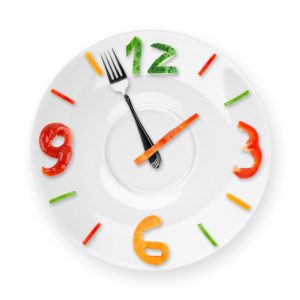
There has been a lot of talk about Intermittent Fasting so I thought I would write some info about it.
Intermittent Fasting, or IF, is becoming more and more popular. IF is when you only eat within a 10 hour or less eating window through the day. During the other 14+ hours, you do not eat or drink any calories. You can choose whatever time frame and time of day that is convenient for you. Many choose to do at least 16:8 (16 fasting hour, 8 eating hours). Also commonly used is 14:10, 18:6, 20:4, and 23:1.
There is also alternate day fasting, or ADF, which can consist of 5:2 (5 days of maintenance calories and 2 very low calories fasting days) or 4:3 (4 maintenance days and 3 very low calorie days). Generally, low calorie days consist of 500-600 calories.
Ideally, you should stick to the same time of day so that you can adapt to fasting. Overtime, your ghrelin (hunger hormone) will adjust and you will not have as much of an appetite outside of your eating window. Choose the time frame that works best for you. I prefer to eat from noon to 8pm; I skip breakfast, eat lunch, and eat a big meal with lots of carbs prior to bed to fuel my workouts in the morning since I workout fasted. (No, it is not necessary or better to workout fasted (1) and carbs at night don’t make you fat (2)).
During your fasting hours, zero calories should be consumed. Calories break your fast. You can, however, have water and other zero calorie drinks such as black coffee (NOT bulletproof, as it contains hundreds of calories), diet soda (no, it won’t make you fat or sick (3,4), tea, and sparkling water. Do not drink BCAAs during your fast. They are NOT calorie free. Yes, your label is wrong. BCAAs are approximately 6 calories per gram which can equate to about 55 to 65 calories per scoop. Not only do they break your fast, they are unnecessary. Eating adequate protein during your eating window will provide you all the BCAAs you need (5.6)
IF does not work on its own for weight loss. There is no extra fat burning component. If you eat 1500 calories while IF, you will get the same results as if you ate 1500 without IF. It is simply a tool used for adherence to your calorie goals. If your goal is weight loss, you must eat in a caloric deficit (7). If you want to gain weight/muscle, you need to be in a caloric surplus. This is why I practice IIFYM in conjunction with IF.
So what are the benefits of IF you ask? For me there are quite a few:
Less frequent meals, which means no lugging around tupperware.
Not as much meal prepping.
Bigger meals that leave me satisfied. I prefer 2 big meals a day.
Less of an appetite through the day.
Better adherence to my macros.
Not constantly thinking about food.
Increased energy.
For those who are overweight, IF tends to help with staying in a caloric deficit; caloric restriction causes weight loss which improves health markers. Other than health benefits derived from caloric restriction, there are no other proven health benefits- at least none in humans yet.
But is IF harmful?
No (8). Unless you are consistently under eating for extended periods, there should be no adverse effects on health or hormones. You’re probably wondering if your metabolism will slow since you won’t be eating every 2 to 3 hours. No, it won’t. That is another myth. You don’t boost your metabolism by eating more often and it won’t slow down by eating less often. Meal timing/frequency does not affect metabolism (2).
Some may be wondering about the effects IF may have on muscle retention or growth. You can build muscle with IF. As long as you get adequate protein and do some strength training, you can preserve or grow muscle. I get all of my protein in two meals. Don’t worry about protein being discarded if in excess of 30g in one sitting; this is another myth (9).
IF is a great tool to have in your arsenal. Personally, I do 16:8 daily and believe it is great to use in combination with IIFYM.
***There’s peer reviewed links below. If you have a legitimate question feel free to ask in our comments, but the peer reviewed facts speak for themselves on this post ![]()
References
1. Schoenfeld, B. J., Aragon, A. A., Wilborn, C. D., Krieger, J. W., & Sonmez, G. T. (2014). Body composition changes associated with fasted versus non-fasted aerobic exercise. Journal of the International Society of Sports Nutrition, 11, 54. http://doi.org/10.1186/s12970-014-0054-7
2. Bellisle, F., McDevitt, R. and Prentice, A.M. (1997) ‘Meal frequency and energy balance’, British Journal of Nutrition, 77(S1), pp. S57–S70. doi: 10.1079/BJN19970104.
3. Grotz VL and Munro IC (2009). An overview of the safety of sucralose. https://www.ncbi.nlm.nih.gov/pubmed/19464334
4. Marjorie L McCullough,* Lauren R Teras, Roma Shah, W Ryan Diver, Mia M Gaudet, and Susan M Gapstur. Artificially and Sugar-Sweetened Carbonated Beverage Consumption Is Not Associated with Risk of Lymphoid Neoplasms in Older Men and Women 1–3. The Journal of Nutrition. October 2014. https://www.ncbi.nlm.nih.gov/pubmed/25342696
5. Dieter, B. P., Schoenfeld, B. J., & Aragon, A. A. (2016). The data do not seem to support a benefit to BCAA supplementation during periods of caloric restriction. Journal of the International Society of Sports Nutrition, 13, 21. http://doi.org/10.1186/s12970-016-0128-9
6. Balage M, and Dardevet D. (2010). Long-term effects of leucine supplementation on body composition. https://www.ncbi.nlm.nih.gov/pubmed/20110810
7. Strasser, B., Spreitzer, A., & Haber, P. (2007). Fat loss depends on energy deficit only, independently of the method for weight loss. Annals of Nutrition and Metabolism, 51(5), 428-432.
8. https://www.ncbi.nlm.nih.gov/pubmed/26384657
9. https://examine.com/…/how-much-protein-can-i-eat-in-one-si…/
BONUS!!
Alan Aragon’s remarks about IF here!
